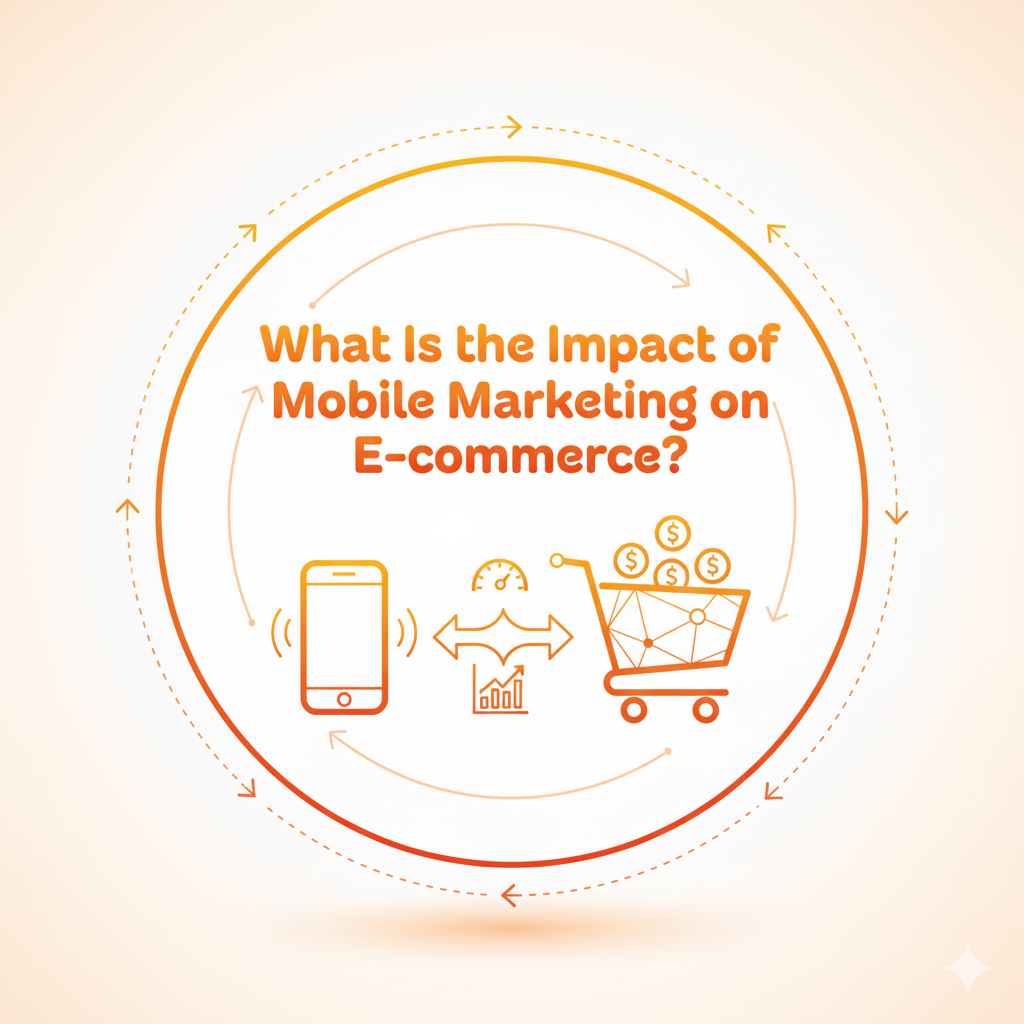E-commerce has transformed the way we shop, and mobile marketing has become one of its most powerful tools. With more people accessing the internet via smartphones than desktops, businesses cannot afford to ignore mobile marketing. But what exactly is the impact of mobile marketing on e-commerce? Let’s break it down in detail.
Understanding Mobile Marketing
Mobile marketing is a strategy that targets users on their mobile devices. This can include:
- SMS and push notifications
- Mobile apps
- Social media ads optimized for mobile
- Mobile-friendly websites and landing pages
- QR codes and location-based campaigns
It’s about reaching your audience where they spend most of their time their phones.
Why Mobile Marketing Matters for E-commerce
Here’s why mobile marketing is crucial in today’s e-commerce landscape:
- Smartphone Usage Is Exploding
- Over 6.8 billion people worldwide use smartphones.
- Most users browse, compare, and buy products using mobile devices.
- Convenience for Customers
- Mobile apps and responsive websites make shopping faster and easier.
- Push notifications and personalized messages keep users engaged.
- Direct Customer Engagement
- Mobile marketing allows brands to communicate directly with customers via messages, app notifications, and social media ads.
- Data-Driven Personalization
- Mobile devices generate data about user behavior, preferences, and location.
- E-commerce businesses can use this data to create targeted campaigns, improving sales and conversions.
Key Impacts of Mobile Marketing on E-commerce
1. Increased Sales and Conversions
Mobile marketing makes it easier for customers to discover, browse, and purchase products anytime, anywhere. Features like:
- Push notifications for abandoned carts
- App-exclusive discounts
- Personalized product recommendations
…have a direct impact on boosting conversions and increasing revenue.
2. Enhanced Customer Engagement
Mobile campaigns help e-commerce businesses maintain ongoing engagement. Social media, apps, and SMS campaigns create a continuous loop of communication. Engaged customers are more likely to make repeat purchases.
3. Better Brand Loyalty
Mobile marketing helps create a personalized shopping experience. Personalized offers, loyalty programs, and timely notifications make customers feel valued. Over time, this builds brand trust and loyalty.
4. Improved Analytics and Insights
Mobile devices generate rich data:
- App usage patterns
- Click-through rates on ads and notifications
- Purchase history and browsing behavior
E-commerce businesses can use this data to optimize marketing strategies, refine product offerings, and predict trends.
5. Location-Based Marketing Opportunities
Geo-targeted campaigns allow businesses to send offers based on a user’s location. For example:
- Special discounts for users near a store
- Notifications about nearby events or sales
This creates highly relevant marketing messages, which increase the likelihood of purchases.
Examples of Mobile Marketing in E-commerce
- Push Notifications: Apps like Amazon send personalized alerts about deals and abandoned carts, boosting conversions.
- SMS Marketing: Retailers send promo codes or flash sale alerts directly to customers’ phones.
- Social Media Ads: Instagram, Facebook, and TikTok ads optimized for mobile drive traffic and sales.
- Mobile Apps: E-commerce apps like Flipkart or Shopify stores make shopping fast, simple, and engaging.
Challenges of Mobile Marketing
While mobile marketing is powerful, there are challenges:
- Ad Fatigue: Too many notifications can annoy users.
- Privacy Concerns: Users are increasingly aware of data privacy, requiring transparent policies.
- Technical Issues: Mobile apps and websites must be optimized for different devices and screen sizes.
Despite these challenges, businesses that use mobile marketing effectively see higher engagement, sales, and customer loyalty.
Future of Mobile Marketing in E-commerce
- AI-Powered Personalization: Predictive analytics to offer personalized recommendations.
- Augmented Reality (AR): Mobile apps allowing users to visualize products in real life.
- Voice Search: Mobile-friendly voice search for faster product discovery.
- Omni-Channel Marketing: Integrating mobile campaigns with email, social media, and offline marketing.
The future is mobile-first, and e-commerce businesses that leverage mobile marketing effectively will gain a significant competitive advantage.
Actionable Tips for E-commerce Businesses to Leverage Mobile Marketing
Mobile marketing is powerful, but to truly benefit, e-commerce businesses need a strategic approach. Here’s a detailed, step-by-step guide:
1. Optimize Your Mobile Website and App
- Responsive Design: Ensure your website adapts to all screen sizes. Mobile users leave if pages are slow or hard to navigate.
- Fast Loading: Compress images, use caching, and minimize scripts for faster page speed.
- Mobile App: If feasible, create a mobile app for a better shopping experience and push notification access.
Tools: Google PageSpeed Insights, Shopify, WooCommerce mobile apps
2. Use Push Notifications Wisely
Push notifications are direct ways to engage users—but only if done correctly.
- Segment Users: Send relevant notifications based on behavior (abandoned cart, previous purchases).
- Timing: Avoid sending too many notifications; choose optimal times based on user activity.
- Personalization: Include the user’s name or product interests for higher engagement.
Example: Amazon reminds users of abandoned carts or low-stock items.
Tools: OneSignal, MoEngage, Airship
3. Implement SMS Marketing
SMS marketing reaches users even without internet access and is ideal for time-sensitive promotions.
- Send flash sale alerts or promo codes.
- Confirm order updates like shipping and delivery.
- Keep messages short, clear, and actionable.
Tools: Twilio, Klaviyo, Gupshup
4. Leverage Social Media Mobile Ads
Mobile users spend most of their time on social media platforms. Ads optimized for mobile can drive traffic and sales efficiently.
- Use Instagram Shopping or Facebook Dynamic Ads for product discovery.
- Run retargeting campaigns to reach users who visited your website but didn’t purchase.
- Create story ads and short videos for better engagement.
Tools: Meta Ads Manager, TikTok Ads, Canva for creatives
5. Personalize the User Experience
Mobile marketing shines with personalization. Use behavioral data to offer:
- Recommended products based on past purchases
- Personalized discounts or loyalty rewards
- Push notifications and email campaigns tailored to individual preferences
Tools: Klaviyo, HubSpot, Salesforce Marketing Cloud
6. Implement Location-Based Marketing
Geo-targeted marketing is unique to mobile. It can increase conversions by sending relevant offers to users nearby.
- Send special discounts to users close to physical stores.
- Promote time-limited offers for local events or holidays.
- Use QR codes in-store for app-based promotions.
Tools: Google Maps API, Radar, Foursquare
7. Use Analytics to Track and Optimize
Data is at the heart of mobile marketing. Track metrics like:
- App installs and usage
- Push notification click-through rates
- Mobile conversion rates
- Cart abandonment rates
Use these insights to refine campaigns, improve targeting, and maximize ROI.
Tools: Google Analytics, Mixpanel, Firebase Analytics
8. Explore Emerging Mobile Technologies
- Augmented Reality (AR): Let users try products virtually (furniture, clothing, makeup).
- Voice Search Optimization: Mobile users increasingly use voice to find products.
- Mobile Wallet Payments: Support UPI, Google Pay, Apple Pay for faster checkouts.
Conclusion
Mobile marketing has a massive impact on e-commerce. It drives sales, improves customer engagement, builds loyalty, and provides valuable data for business growth. With smartphones dominating internet usage, e-commerce businesses cannot ignore mobile strategies.
The key to success lies in personalization, relevance, and user-friendly experiences. Businesses that master mobile marketing will not only survive but thrive in today’s digital commerce landscape.
FAQs
Mobile marketing is crucial in e-commerce because most online shopping happens on smartphones today. People browse, compare products, and make purchases directly from their mobile devices.
Key reasons it’s important:
Direct Engagement: Push notifications, SMS, and app messages let you reach customers instantly.
Convenience: Mobile marketing allows users to shop anytime, anywhere, boosting conversions.
Personalization: Mobile campaigns can use behavioral data to target specific users with relevant offers.
Higher ROI: Mobile ads and campaigns often cost less than traditional marketing but deliver higher engagement.
Without mobile marketing, e-commerce businesses risk losing a huge portion of potential customers who prefer smartphones over desktops.
Mobile technology has completely changed how e-commerce operates. Here’s how:
Shift to Mobile-First Shopping: Websites and apps are now designed primarily for mobile users.
Rise of Apps and Marketplaces: Platforms like Amazon, Flipkart, and Shopify apps have made shopping faster and easier.
Mobile Payments: Secure mobile wallets and UPI systems have simplified transactions.
Data-Driven Marketing: Smartphones provide rich data for personalized campaigns and predictive marketing.
Social Commerce: Mobile-friendly social media platforms allow users to shop directly from ads or posts.
In short, mobile technology has made e-commerce more accessible, faster, and more personalized, shaping modern shopping habits.
Mobile technology has transformed selling in several ways:
Wider Reach: Sellers can reach global audiences without physical stores.
Personalized Offers: Data from mobile devices helps sellers send targeted discounts and recommendations.
Higher Engagement: Push notifications and app interactions keep customers coming back.
Faster Transactions: Mobile wallets and one-click checkouts increase conversion rates.
Analytics for Optimization: Sellers can track mobile user behavior to improve products, campaigns, and strategies.
Basically, mobile technology makes selling easier, faster, and more profitable for e-commerce businesses.
E-commerce has wide-ranging impacts on businesses, customers, and the economy:
For Businesses:
Lower operating costs compared to physical stores
Ability to sell globally 24/7
Direct communication with customers and data-driven insights
For Customers:
Convenience of shopping anytime from anywhere
Access to a wide variety of products and competitive pricing
Personalized shopping experiences
For the Economy:
Growth of digital businesses and startups
Creation of jobs in logistics, tech, and marketing
Encouragement of innovation in payment systems, delivery, and technology
In short, e-commerce benefits businesses, customers, and economies, making it one of the fastest-growing sectors in the world.



Pingback: What Is E-Commerce Experience? A Complete Deep-Dive for Online Store Owners - Pratsify
Pingback: Mobile Marketing for eCommerce: The Complete Guide - Pratsify